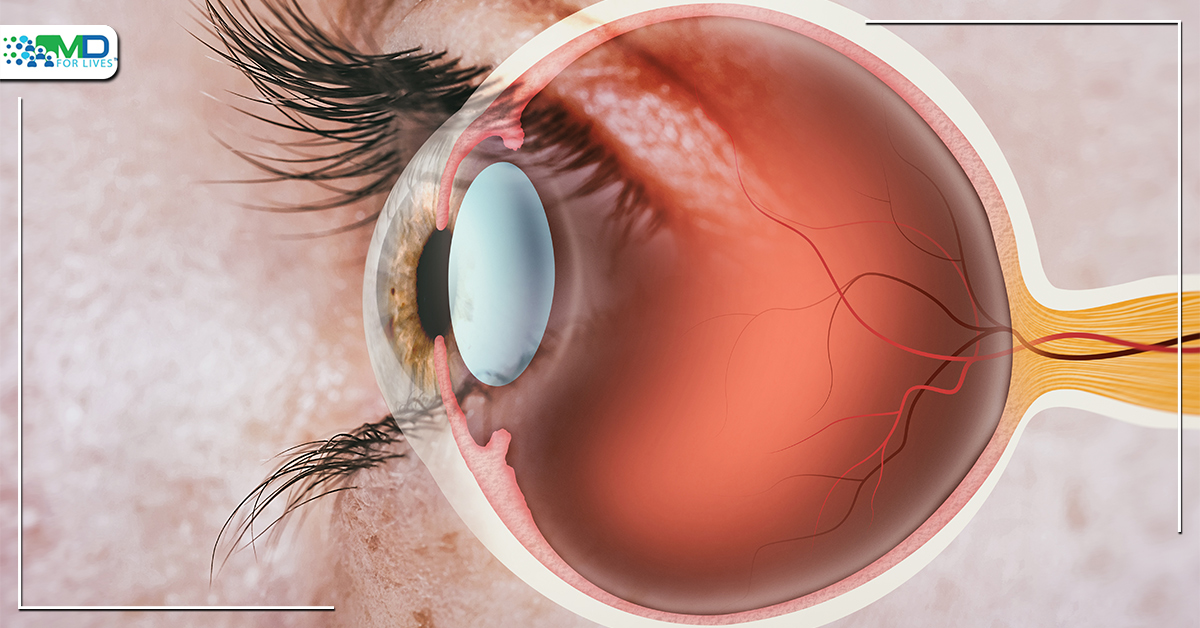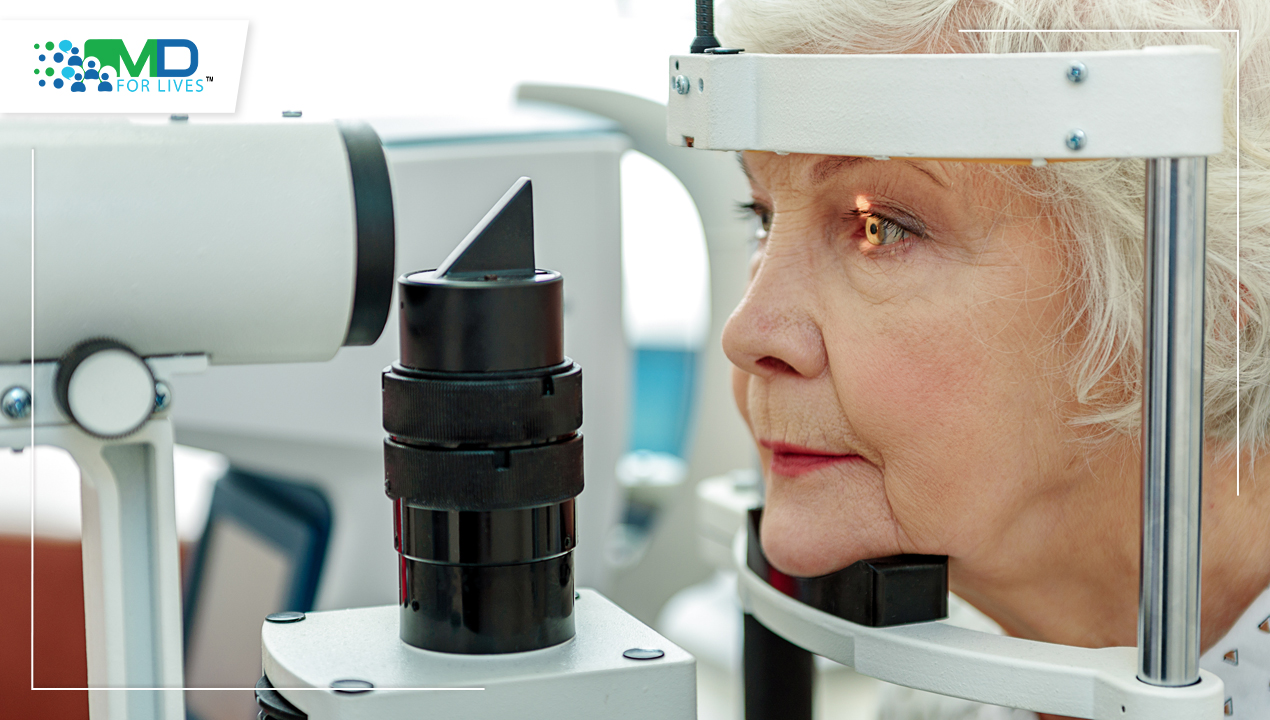Glaucoma is a set of eye illnesses that damage the optic nerve in the back of the eye, causing vision loss and blindness. This occurs when fluid accumulates in the front of the eye. The extra fluid in the eye raises the pressure, causing damage to the optic nerve. It is a leading cause of blindness in people above 60. Blindness can be prevented with early treatment. Glaucoma affects more than 3 million Americans, with the most common kind, open-angle glaucoma, affecting 2.7 million of those aged 40 and older.
Below is the statistics from NCBI showing the trend of the increase in the number of people (aged 40–80 years) with glaucoma worldwide:

Types of Glaucoma
There are two major types of Glaucoma
· Primary open-angle glaucoma
Glaucoma of this type is the most frequent. It’s a slow process in which the eye doesn’t drain fluid as well as it should (like a clogged drain). As a result, eye pressure rises, causing optic nerve injury. This type of glaucoma is painless at first and does not cause vision abnormalities.
- Acute angle-closure glaucoma (closed-angle glaucoma/narrow-angle glaucoma/angle-closure glaucoma)
This type occurs when the iris of a person’s eye is very close to the drainage angle. The iris obstructs the drainage angle. Eye pressure rises quickly when the drainage angle is totally blocked. This is known as an acute attack. It’s a serious eye emergency, and you should contact your ophthalmologist immediately or risk going blind.
Another common type of glaucoma other than the above two is pigmentary glaucoma
- Pigmentary glaucoma
Pigment granules that are normally attached to the back of the iris (the coloured portion of the eye) fall into the clear fluid produced in the eye, known as the aqueous humour, resulting in pigment dispersion syndrome (PDS). These particles can sometimes find their way into the eye’s drainage canals, slowly blocking them and boosting ocular pressure. This increase in eye pressure has the potential to harm the optic nerve, which is the nerve in the back of the eye that transmits visual information to the brain. Pigment dispersion syndrome becomes pigmentary glaucoma if this happens.
Causes of Glaucoma
More than a million microscopic nerve fibres make up the optic nerve. It resembles an electric cable, which is made up of many little wires. When these nerve fibres die, you will get blind patches in your vision. It’s possible that you won’t notice these blind patches until the majority of your optic nerve fibres have died. You will go blind if all of your fibres die.
Our eye constantly makes aqueous humour. As new aqueous enters our eyes, the identical amount of aqueous should drain out. The fluid exits via a section known as the drainage angle. The intraocular pressure (IOP) in the eye is kept constant with this method. Fluid accumulates if the drainage angle is not functioning properly. The optic nerve is harmed as the pressure inside the eye rises.
Glaucoma Symptoms
· Open-angle glaucoma symptoms
Early signs of open-angle glaucoma show no warning signs or symptoms. Blind areas in peripheral (side) vision develop as the condition progresses.
The majority of patients with open-angle glaucoma do not detect any changes in their vision until the disease has progressed to the point where it is irreversible. An ophthalmologist can diagnose this disease before it causes vision loss with regular eye exams and notify how often one should get their eyes checked.
· Angle-closure glaucoma symptoms
Angle-closure glaucoma patients witness blurred vision, halos, minor headaches, and eye pain as some of the early signs of the disease. People who experience these symptoms should see an ophthalmologist as soon as possible. Angle-closure glaucoma exhibits itself in the following ways: Severe headache, redness of the eye or forehead, poor vision or impaired vision seeing rainbows or haloes, glaucoma, nausea, and vomiting.
What are the symptoms of glaucoma in humans? Am I at risk?
Glaucoma can affect anyone, but some people are more susceptible than others. If you fall in any of the following categories, you’re at a higher risk:
- Age above 60, particularly if you are Hispanic/Latino
- African-American and over 40 years old?
- History of glaucoma in your family?
- Have high eye pressure?
- Consumption of long-term steroid drugs
- Farsightedness or near-sightedness
- Eye injury
- Have diabetes, migraines, high blood pressure, poor blood circulation, or other health problems that affect the entire body.
Consult your doctor about your glaucoma risk and how often you should be checked. A full dilated eye exam should be done every 1 to 2 years if you’re at a higher risk.
Types of Glaucoma Tests/Glaucoma Screening
The key to protecting eyesight against glaucoma damage is early detection, which can be achieved through regular and comprehensive eye exams. Five typical glaucoma tests are included in a comprehensive eye exam. Before making a glaucoma diagnosis, five variables should be checked to ensure safety and accuracy.

- Tonometry – It is a test that measures the pressure inside one’s eye.
· Ophthalmoscopy – This diagnostic process allows your doctor to check for glaucoma damage in your optic nerve.
· Perimetry – Perimetry is a visual field test that generates a map of your whole visual field. This test will assist a doctor in determining whether or not you have glaucoma.
· Gonioscopy – This test determines if the angle between the iris and the cornea is open and wide or closed and narrow.
· Pachymetry – It is a non-invasive test used for the determination of the thickness of the cornea.
Glaucoma Treatment
- If you have glaucoma, it’s crucial to begin treatment as soon as possible. Treatment won’t make your vision better, but it will keep it from getting worse.
- Medicines – Prescription eye drops are the most usual treatment. They reduce the pressure in your eye and protect your optic nerve from harm.
- Treatment with a laser – Doctors can use lasers to assist the fluid drain out of your eye to lessen your eye pressure. It’s a straightforward treatment that your doctor can perform in his or her office.
- Surgery – If medications and laser treatment fail to help, your doctor may recommend surgery. There are numerous forms of surgery that can help in draining fluid from your eye.
Can Glaucoma Be Stopped?
Glaucoma damage is irreversible; there is no way to reverse it. However, drugs and surgery can help prevent additional damage. Your ophthalmologist may employ one or more of the following therapies to treat glaucoma.
Cataracts vs glaucoma
The main distinction between these two eye disorders is that they are caused by different things. A buildup of fluid inside your eye causes glaucoma. An accumulation of broken-down proteins in your eye causes cataracts.
- Glaucoma is caused by an increase in eye pressure and affects the optic nerve, whereas cataracts are generated by protein breakdown and damage the lens.
- Depending on the type of glaucoma and severity, glaucoma can be slow and mild or rapid and painful. Cataracts are painless and gradually grow.
- Although cataracts are less likely to cause vision loss, glaucoma can cause irreversible blindness.
- Cataract surgery results in vision loss that can be reversed, whereas acute angle-closure glaucoma cannot.
- Unlike cataract surgery, which removes the lens and replaces it with an artificial lens,
glaucoma surgery employs a laser to clear clogged canals that prevent fluid from draining.
- Cataracts are not a life-threatening medical issue, whereas glaucoma requires prompt diagnosis and treatment.
Recent Research on Glaucoma
- https://glaucomafoundation.org/the-glaucoma-foundation-tgf-awards-250000-grant-for-project-forecasting-glaucoma-progression-using-artificial-intelligence/, https://pubmed.ncbi.nlm.nih.gov/33497675/, https://pubmed.ncbi.nlm.nih.gov/31323204/
TGF has awarded $250,000 to a research team at the University of California, San Diego, the US, for a two-year project that will use Artificial Intelligence (AI) to better predict the progression of glaucoma and the need for surgery.
- https://www.nature.com/articles/s41467-021-26346-0
Scientists in their experiment conducted on mice found out that they were able to replace the function of genes that cause glaucoma when they were mutated by injecting a new, long-lasting, and nontoxic protein treatment (Hepta-ANGPT1) into them. This injectable treatment prevented the development of both the types of glaucoma primary congenital glaucoma found in children and open-angle glaucoma found in adults.
- https://bjo.bmj.com/content/early/2021/08/18/bjophthalmol-2021-319232
A common class of diabetes drugs known as GLP-1R agonists (Trulicity and Rybelsus) may also protect diabetic people from glaucoma, according to a recent study headed by experts.
References






